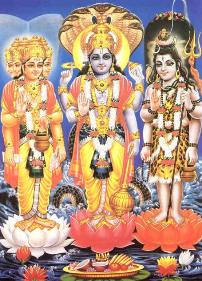 |
Essence Of
Brahma Purana
|
| 17 Quick Review of Bharata Varsha’s Prominent Tirthas | |
Lord Brahma asserted that Purushottama Tirtha was indeed the best rated among all the Tirthas in Bharata Varsha where a human being ought to stay for a year or a month or atleast visit once in a life time and imbibe as much of Brahma Vidya as possible to perform Puja, Japa, Homa, Daana and Tapasya in favour of Yogeswara Shri Hari and most certainly avoid further involvement of the vicious circle of life-death-and life again! The Munis at Nimisha expressed gratitude for the narration of the Mahatmya of this Tirtha Raja and desired however about the other significant Tirthas on Bharata Varsha, keeping in view the obvious limitations of movement from various other regions of the Trilokas. Thus Brahma outlined some of the other significant Tirthas in the Karma Bhumi of Bharata.Within Himalayas and Vindhyas there were twelve Deva Sambhava Nadis/ Rivers materialised by Devas of utmost importance which were closely associated with Brahma-Vishnu-Maheswaras-six of them from Himalayas to Vindhyas viz. Bhagirathi, Narmada, Yamuna, Saraswati, Vishoka and Vitasta and six more from Vindhyaparvata to Dakshina Samudra viz. Godavari, Bhimarathi, Tungabhadra, Krishnaveni, Tapi and Payoshni. Of these Asura-Sambandha Nadis viz. Gayasura, Kollasura, Vrittha, Tripura, Andhaka, Hayamurtha, Lavanasura, Namuchi, Shrinka, Yama, Patalaketu, Maya, and Pushkarasura.Then there were Rishi-Sambhava Nadis viz. Prabhasa, Bhargava, Agasti, Nara Narayana, Vasishta, Bharadwaja, Goutama and Kashyapa. These Tirthas apart, there also were Illustrious Manushya Sambhava Nadis in the memory of Ambarisha, Harischandra, Maandhata, Kuru, Kankhala, Bhadraashwa, Sagara, Ashwayupa, Nachiketa, Vrishaakapi, and Arindama. Countless other Rivers, Sarovaras and Tirthas dotted the length and breadth of Bharata Varsha but Brahma Deva mentioned the more popular ones. Following was a concised version of the more significant ones highlighted by Brahma: | |
 Prev:Nrisimha, Sweta Madhava and Matsya Madhava Mahatmyas Prev:Nrisimha, Sweta Madhava and Matsya Madhava Mahatmyas
| |
 Next:Nrisimha, Sweta Madhava and Matsya Madhava Mahatmyas
Next:Nrisimha, Sweta Madhava and Matsya Madhava Mahatmyas